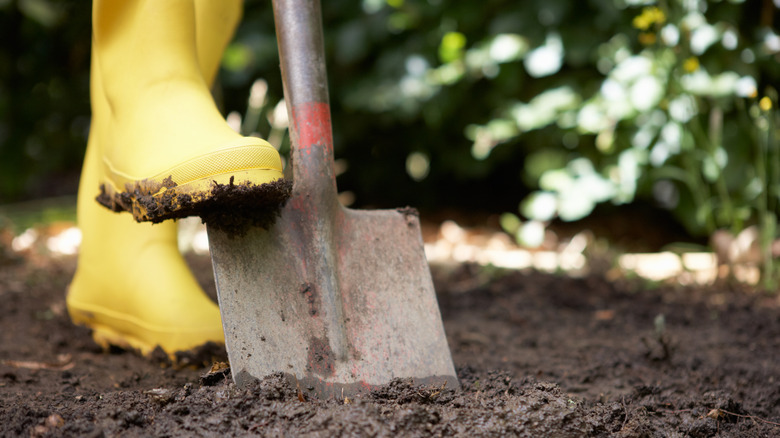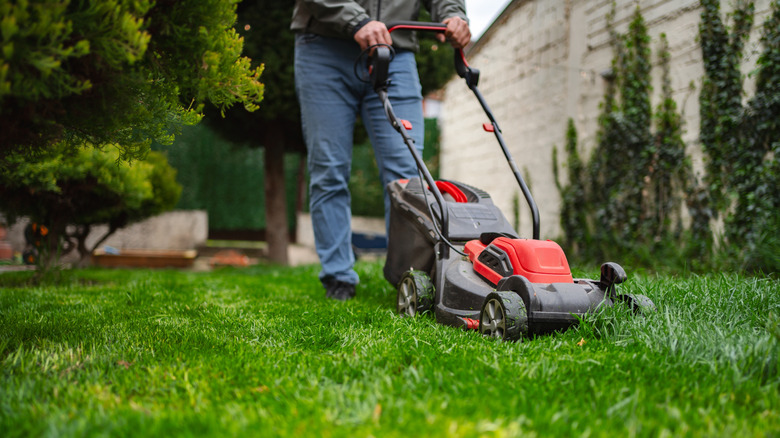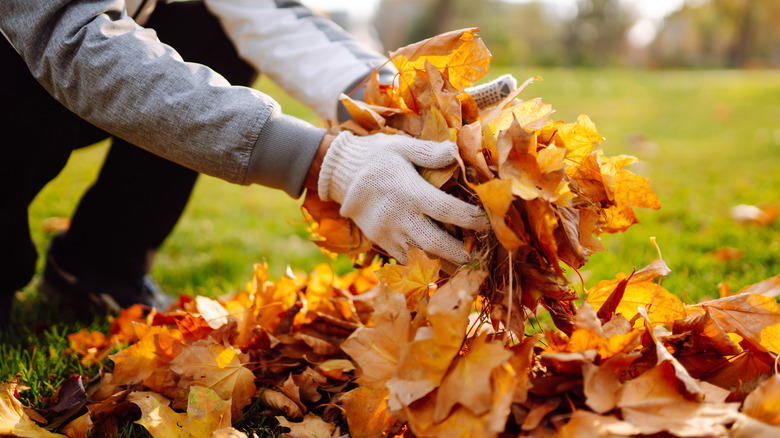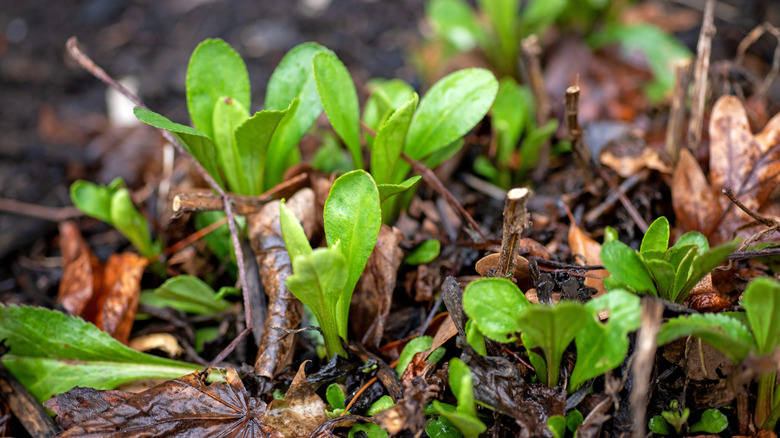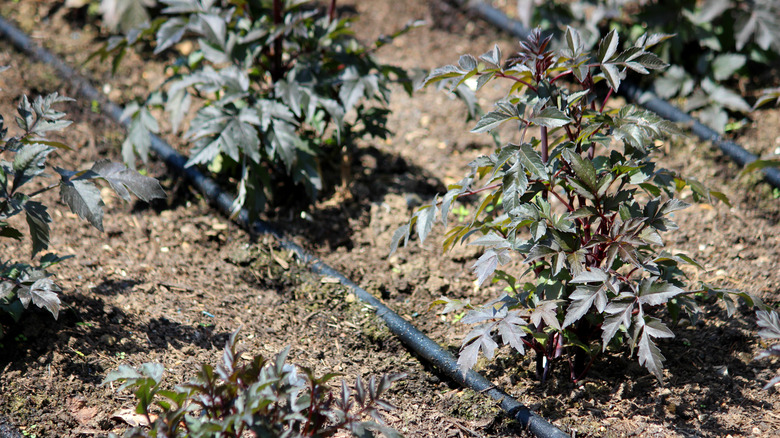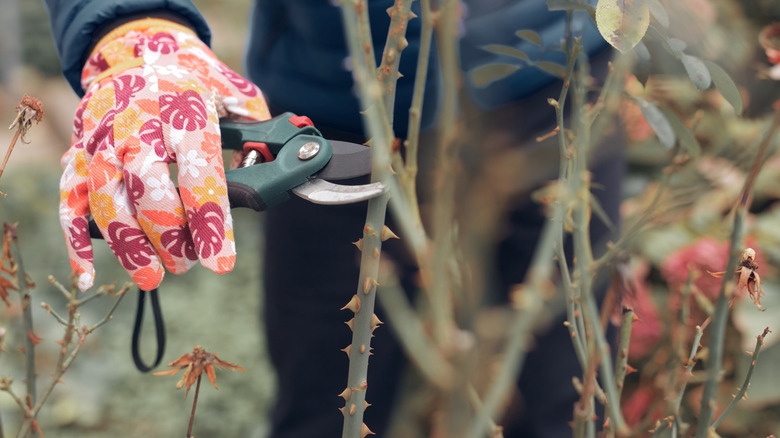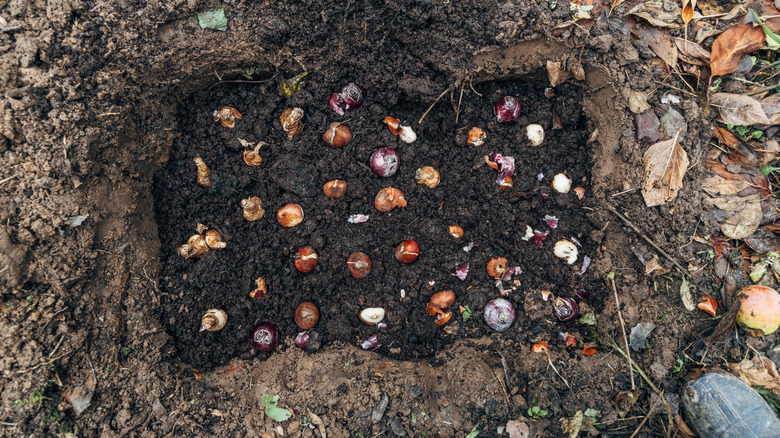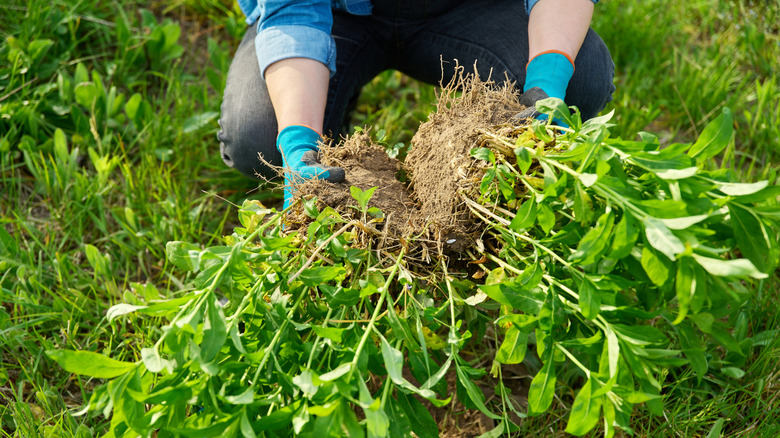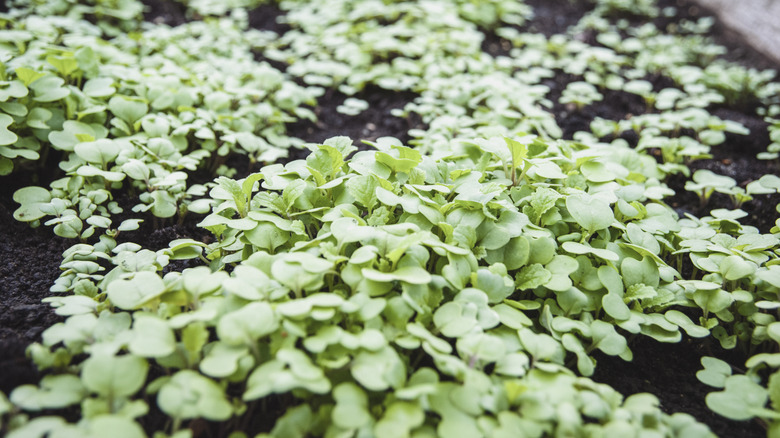13 End-Of-Year Gardening Mistakes To Avoid For A Beautiful Spring
We may receive a commission on purchases made from links.
I'm a master gardener, and I can tell you the end of the year is where a lot of people quietly sabotage their spring garden without realizing it. Whether because you're tired or the weather's grim (or both!), it's tempting to either ignore the garden or tidy everything within an inch of its life. Instead, to ensure a successful garden come spring, you want to protect your soil and your plants as they rest throughout the winter season.
There are many common end-of-year gardening mistakes I see people make that can easily be avoided. For example, don't tread on your wet or frozen soil, and don't make things too sterile. It's best to be patient, and remember that your garden is a living, synergistic system. Avoid these bad, but often well-intentioned, habits I see made over and over that turn gardens into bare patches with dead plants and disappointing spring growth.
Working with wet soil can affect its structure
Working your soil when it's wet is probably the biggest gardening mistake you'll make this time of year. Time is running short and even though you know that it's probably too wet, you rush to get your tasks done. While walking on, or digging in, soil that's too wet seems harmless, it's actually very damaging. You compress the soil, eliminating air pockets, ruining the structure, and starving many of the organisms that are essential for soil health. Plant roots also suffer, as compacted soil lacks oxygen, so it's difficult for roots to grow through. It's also colder than soil with good structure, and it gets waterlogged. Additionally, in spring, compacted ground takes longer to warm up and holds water for longer.
You might think that it's worth the risk, as you can just dig it over in spring, but unfortunately, there's no quick fix for compacted soil. It's a lot of hard work and takes up to two years to re-establish healthy soil structure. You have to let the soil drain, then slowly add in lots of rough organic matter that builds better structure.
Before you leap into last minute winter gardening, do a quick soil test. Grab a handful and squeeze it into a ball. If, when you open your hand, it stays at a wet, slick ball, it's too wet. If it is dryish and crumbles when you open your hand, you are good to go. If you stand on the soil and it squelches around your boot, it's too wet. If you really must cross wet soil, lay wide flat boards and walk on those to spread the pressure.
Mowing too short or mowing when your lawn is dormant puts it at risk
Scalping your lawn is incredibly damaging in cold weather. Depending on the type of grass you have, cutting it lower than 2 1/2 to 3 inches when it is basically entering dormancy reduces its ability to heal. Additionally, the longer grass blades actually protect the roots and the crowns from low temperatures.
So, by cutting it short now, you expose the more tender roots and crowns to potentially killing cold, resulting in dead patches and an overall dull, lackluster lawn that will take many months to recover. You also increase the risk of snow mould. By stressing the lawn as it goes into winter, you reduce root reserves and end up with a patchy lawn that takes much longer to green up in the spring. Keep the height to around 3 inches. Then, stop mowing your lawn in fall when the grass stops growing, even if you have a few longer patches that you think "needs a tidy up." Resist temptation and leave your grass alone.
Walking on frozen grass can physically damage it
I love how the garden looks in the early morning when it's covered in a sheen of sparkly white frost. When you're all cozy indoors and see your frosty lawn, it's a little bit magical. But actually, the grass blades are rigid and full of ice crystals — hence the sparkle. And when you walk over a lawn that's deeply frozen, you shatter those crystals, which can shatter the grass blades, too. Notice that if you do this repeatedly, your footprints will linger for months because the grass is dormant and can't recover from the stress.
It's not technically the frost that's the problem. If you leave it to thaw naturally, your lawn will bounce back with vigor in the spring. The foot traffic is the issue, especially if a frozen lawn is getting trampled regularly. Because the plant tissue is frozen and full of ice crystals, it's brittle. So, when you walk across it, you fracture the leaves. Plus, the crowns sitting just below the grass blades will also be frozen and more prone to damage from excessive pressure. Damaging the crowns can result in large dead patches and you may even need to reseed once your lawn is growing again.
Fertilizing late sets your plants up for failure
I see so much bad advice about setting your garden up for next spring by applying a final heavy dose of fertilizer late in the year. It's a terrible idea, though, and you shouldn't do it. Adding a general-purpose or nitrogen-rich fertilizer late in the season does more harm than good. That's because nitrogen late in the year confuses your plants and encourages leafy growth. In late fall and winter, a flurry of new foliage looks great for a short period, but it can't harden off before the frosts. Winter-burned new growth dies off rapidly and has a higher chance of contracting a fungal disease. It also weakens the whole plant. Encouraging new growth with nitrogen fertilizers forces the plant to use its energy reserves that it should be storing for winter survival.
If you're worried about your soil health, before just randomly applying an all-purpose feeder, get a soil test. Luster Leaf's Rapitest Soil Test Kit is a solid, easy-to-use option. I'm an organic gardener, so I don't use synthetic additives anyway. But, this time of year, you can finely shred fallen leaves and rake them over your lawn to act as insulation and as a slow-release natural soil improver. You can also use shredded leaves, homemade compost, or well-rotten (never fresh) manure on beds as a top dressing or mulch that protects the soil and slowly releases balanced nutrients over the winter and into spring, improving soil health without confusing or distressing your plants.
Leaving dense leaf blankets can lead to fungal diseases
Fallen leaves are the ideal mulch and one of the most helpful, yet underutilized, free resources your garden provides. Shredded, and applied in loose layers, they make amazing mulch, providing insulation, protection, and slow nutrient-release. They fuel soil life and protect your plants. But leaving them in thick mats is a bad idea. Dense, matted layers of leaves just sitting on the soil — or worse — covering plant crowns, creates all kinds of issues. Not least of which is that they can harbor and encourage fungal diseases that can proliferate in the warm, damp layers. Then, once new spring growth appears, the fungal pathogens spread fast.
If you let a dense layer of unshredded leaves cover perennial crowns, you may think you're adding insulation, but you're actually trapping moisture against the crowns. This leads to crown rot and snow mould. So, make sure you shred leaves. You can do it simply by setting your mower to the lowest cut height and repeatedly mowing over them. Then you can just rake them up and apply in a thin layer over your lawn, around your perennials, under shrubs, and as cover on bare patches.
Mulching incorrectly can trap moisture and cause rot
Skipping mulching altogether exposes soil, causes erosion and nutrient depletion, and leaves vulnerable roots and crowns exposed. But over-mulching, or creating mulch mountains, is also destructive. One of the biggest mulching mistakes is mounding mulch too close to tree trunks and perennial crowns, which traps moisture and invites rot and disease. Plus, it gives rodents and insects a place to overwinter and wreak havoc on your plants, undetected until spring.
I'd also strongly recommend waiting until the ground actually freezes. Lots of people rush out and try to lay their mulch before the deep winter really kicks in, but it's better for your soil to wait until you get a few hard frosts and the ground firms up. This keeps the soil temperature at a more consistent level and reduces the risk of roots and crowns heaving up out of the soil as the temperature fluctuates.
Apply mulch in a donut, leaving 2 to 3 inches between the plant and the mulch ring. You also want to make sure you cover the whole root zone, ideally. This obviously isn't possible with huge, established trees, but with shrubs, perennials, and younger trees, I'd highly recommend it. Mulching the whole root zone maintains a more consistent temperature across the entire area, giving you stronger, healthier plants that get an earlier start in the spring.
Not protecting tender perennials that need assistance
Just because a plant is classified as perennial, doesn't mean it can necessarily survive all winter without a little protection. Your USDA Hardiness Zone and the plant in question determines what, if any, level of protection is necessary to get through the winter. Where I live, for example, established rosemary plants and other salvias need no winter protection, but in colder climates, they need to be brought indoors or insulated in-situ to survive.
If a plant is considered tender or borderline-tender in your area, just letting nature do its thing is the fastest way to kill your plants or weaken them so that they get off to a poor start in spring. For tender bulbs, corms, or tubers, you'll want to lift them and store them frost-free until spring. If plants are well-established and in the ground, you can add insulation in the form of mulch or floating row covers. It's also a good idea to leave healthy stems long to catch snow that acts as an extra insulating layer.
Containerized tender perennials are much more prone to winter damage than those in the ground. There's less soil to insulate the roots, and the container sides are exposed, so it gets colder quicker. Plus, many people make the mistake of leaving them standing on concrete, which just leaches away heat. If you can't bring the containers into a frost-free greenhouse or sheltered spot, press the containers into a bare patch of soil. You can even half-bury them. Alternatively, group them together and wrap with burlap (I like the Buryeah 40-inch by 33-feet Burlap Fabric Roll) and bubble wrap for insulation. Just make sure they aren't standing on concrete or metal.
Both stopping watering too early or watering too late can lead to issues
For most people, they fall into one of two watering categories: They either think plants need no water from mid-fall onwards, or that they keep watering every week right through the winter. The truth is somewhere in the middle. Not giving your plants a deep soaking in late fall, before the frosts hit, means they go into dormancy weak and stressed. Dry, dehydrated roots and soil are more prone to desiccation and winter damage. On the other hand, watering when the ground is already frozen can cause root rot as the water can't drain away.
The right way is to water deeply using a slow drip setup or a soaker hose, like this XDRSIXA Heavy Duty Soaker Hose, before the ground freezes and the temperature consistently dips below 40 degrees Fahrenheit. Your aim is to soak the whole root zone, deeply — ideally to about 6 to 9 inches. Then no more watering until spring, unless you have a particularly dry, windy winter. In which case, you need to choose a day when the soil isn't frozen, and water as early in the day as possible so the water soaks in before the colder nighttime temperatures.
Pruning too late weakens the plant's ability to survive winter
The only pruning you should be doing in late fall is removing diseased or damaged wood. Late season pruning, before a plant goes fully dormant, can encourage a late surge of new leafy growth. And, just like with late fertilizing, this growth won't survive and uses up the plant's stored reserves that it needs to get through winter strong. It's also important to know what you're pruning and why. For plants that flower on last year's growth, you need to be careful to not cut off the wood that contains the new buds.
As a general rule, prune spring-flowering shrubs once flowering has finished in late spring or early summer. For those that bloom on new wood, tackle the pruning in late winter, when the plant is fully dormant. Pruning when the plant is dormant means that you won't trigger new growth.
Overcrowding spring bulbs results in a poor spring show
Spring bulbs can be layered if you do it right, but overcrowding them excessively will result in a poor show in spring. If you're lucky you'll get mediocre foliage, but you'll get very few blooms. The same happens if you plant too shallow or deep — you'll also deplete soil nutrients. When you overcrowd bulbs, at a similar depth, they all compete for the same small pocket of nutrients, which results in sad, exhausted spring plants.
Check the spacing and depth instructions for your particular bulbs and stick to it. To avoid blind clumps, which is where you get loads of leaves, but no flowers, give your bulbs plenty of space. Instead of cramming extra bulbs in "just because," find a spare patch for them or give them to a neighbor, and you'll get a much better showing in spring. If you've got existing bulb clumps that are struggling, you'll want to lift, divide, and move them — but not while the bulbs are actively growing. For the strongest growth the following spring, lift the bulbs in late fall, once the foliage starts to die back.
Dividing plants too late doesn't allow for strong enough root growth
Now, ideally, you want to divide plants, at the very latest, four weeks before the first predicted frosts in your area. That gives new divisions and plantings time to grow roots strong and deep enough to anchor themselves in the soil and to build up some winter reserves before the ground freezes. I know it's tempting to just chance it, but when you cut it too close, your divisions go into winter with barely any root regrowth. That means they're not anchored in the soil properly, and because the roots sit so close to the surface and the bulbs have so few reserves, the roots desiccate or rot.
If it's too late, then wait — unless they're bulbs or plants that can be lifted, divided, and overwintered in a cold, but frost-free location like your garage. Otherwise, wait until the weather warms and the ground thaws in early spring. While early spring division isn't ideal, it's much better than late divisions. If you're reading this and kicking yourself because you've already done the divisions, but realize you're too late, it's okay. You can heavily mulch over the root zone and lay a frost blanket over the top for extra protection. And make sure you water more frequently during dry (but thawed) spells. Your other option is to lift the divisions, plant them in containers, and keep the containers insulated and protected.
Clearing the wrong things can block beneficial pollinators
I understand the urge to get out in the garden and give it a darn good tidy before the end of the year, but don't — or at least don't do it randomly or make things too sterile. You definitely want to clear away old fallen fruit and any stems or foliage that looks diseased. Mummified or rotting apples, leaves showing signs of mildew or leaf spot, and blighted tomato and potato foliage are all common examples. Getting rid of this is important as you don't want to allow diseases and pests to overwinter and infect healthy plants. Remove and (if allowed) burn them. Otherwise, bag them and put them in the trash. You can't risk composting them or you'll infect your compost and then, when you spread the compost, you'll spread the pathogens further.
Don't go mad though. You want to preserve long stems if they're healthy. Hollow and pithy stems create a safe habitat for beneficial insects that eat pests and pollinate your garden in spring. Plus, they catch fallen leaves and snow that protects crowns and soil. I also think the spent heads of many flowers have their own special stark beauty that adds texture and interest to the winter garden.
Not protecting bare soil that can be stripped of its nutrients by the elements
There are plenty of plants that need mulch in the winter, but so does your soil. If soil stays bare over winter, it's exposed to rain and wind. The rain causes nutrient run-off and the wind scours the surface, desiccating it and stripping away nutrient-rich top soil and organic matter. The surface can seal and turn crusty, too, which leaves you with nutrient-poor, compacted soil that'll need lots of work if you want to grow healthy plants in spring. Protected soil is much easier to work in spring. It also warms faster, drains better, and gives plants a better start.
You've got a few options here. My favorite method is growing green manure, like a mix of clover and peas, to keep weeds at bay and fix nitrogen in the soil. This also protects the soil surface and, when you turn it back into the soil in the spring, you add nutrient-rich organic matter. You can also go with a 2 to 3-inch layer of compost, shredded leaves, or straw. Even clean cardboard weighted down with wooden boards will work to keep the soil healthy.

